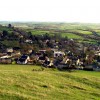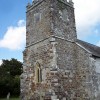“Please treat the church and houses with care. We have given up our houses where many of us have lived for generations to help win the war to keep men free. We shall return one day and thank you for treating the village kindly.”
These heart-felt words, pinned to the door of a church at a time of great desperation during the dark days of World War II could hardly have been more ignominiously dishonoured through the insensitivity of officialdom. The church was that of Tyneham near Worbarrow Bay in east Dorset and the tragedy behind those words written in good faith was for them never to be respected by faceless ministers, never to be honoured when the victory was won. Seldom has the expectation of happier days been more brutally betrayed by the eventual reality, by what the passage of time would tell.
The catastrophe, which brought the Tyneham villagers’ world crashing down, and left their community to rot amidst bats and owls, struck on December 19th 1943 with an official notice from Southern Command. With the most appalling sense of timing imaginable the entire population was to be evacuated, virtually with immediate effect. A close-knit community which had peopled and shaped a village for generations was to be ousted by the military without even the decency of being permitted to spend one last Christmas in their own homes.
Inevitably the question would arise: could not the military have waited but one more week? The military chose not to. Tyneham – and a huge area of pristine Purbeck downland, were commandeered for use as a tank gunnery school. The Army, it seemed, needed all those undefiled acres as ranges for tank training – with live shells.
Notwithstanding the cold, wet December of 1943, the young, the old, the halt and sick were callously pitched from their ancestral dwellings, many to be re-located by the compassionate Town Council of Wareham. Others had relatives to go to, or took “temporary” accommodation. Pupil, postman, parson, gardener, teacher, builder, baker – all were forced out with their chattels under the premise of a noble sacrifice for the duration of an emergency. Those offered subsidised council housing in Wareham could regain some semblance of a normal life, and the town’s Tyneham Close bears witness to where the displaced were re-housed. For the young, some re-adjustment to the new circumstances was possible; though gnawing pangs of homesickness would never fore-sake them.
The old of course were not so fortunate. Jack Miller, an ageing fisherman who owned a cottage overlooking Worbarrow Bay, was offered a condemned cottage at Langton Matravers for himself and his wife, but was dead from bronchitis not long after the end of the war. Langton’s windy and foggy atmosphere gave Mrs Miller arthritis, despite the Women’s Voluntary Service labouring on the Miller’s behalf to make their home from home habitable.
Boatbuilder Will Strickland was another fellow villager who also did not long survive his displacement. People like Strickland, who made their living from the sea felt they had nothing more to live for once they became estranged from it. The once sturdy health of these old salts was broken. They ailed, and like a dog, which loses a beloved master they pined, suffering that great death of the spirit so often the precursor to the death of the body.
On VE Day (only 17 months after the evacuation) none of the evacuees in Wareham and elsewhere dared to raise their hopes too highly that the Purbeck ranges would now contract or be closed. By 1946 nothing had changed, prompting the Tyneham villagers and their supporters to begin a long campaign for the return of their valley to civilian occupation. Following the lapse of wartime censorship for security reasons the villagers could expect press publicity about their plight to begin to circulate nationwide. ‘The New Statesman’ and ‘The Star’ were notably in the vanguard in bringing the Tyneham case to national attention.
In March 1948 a two-day public enquiry was convened after news broke that the derelict homes in Tyneham were to be compulsorily purchased. Acting on behalf of the Tyneham people J. Scott Henderson KC made a watertight case for the return of the ranges to peaceful uses. The clay-pit workers and miners of the area, natural history societies, the YHA and NFU, and several other organisations and churchmen with vested interests also pressed for the War Department’s pledge of withdrawal to be honoured.
What emerged from this enquiry was that the Government did acknowledge that the withdrawal pledge had been made; yet the area was still required by the Army. The reason, as Brigadier Duncan for the War Department explained, was that by 1942 American tanks required a range of over 2,400 yards, so that there could be no contraction of the target area. It was this simple most important fact that underpinned why such an extensive area was needed; why a century’s old community found itself in the line of fire.
For the displaced villagers, who became more expectant that re-occupation could be nigh, the compulsory purchase was a devastating blow. At a hastily convened meeting in Wareham the then Minister of Town and Country Planning, Lewis Silkin, broke the bad news. The only comfort he could offer was that: “every effort would be made to make sure that when firing does not take place the public should have access to the road to Worbarrow Bay.” Those who contested the CPO were informed their properties would be requisitioned anyway.
At the time of this enquiry the Tyneham, Lulworth and Holme Ranges – together with Bovington – occupied about 11,500 acres! Tyneham House, for generations the village’s cosy manor, was boarded up by a mason. Then an uneasy peace descended upon the ranges. The exiles, as best they might, never gave up hope of one day being able to return to re-purchase their properties and repair the effects of target damage and the elements.
Then in 1960 the War Department gave the screw another turn. Territorial demands were extended still further, with the closure of more roads and rights-of-way to the public within the range area. Angry letters flew to the local MP, the Transport Minister and the War Department. In January 1961 an extension to the closure to certain roads on the East Holme and Lulworth Ranges prompted further enquiries in Dorchester.
However, hopes of liberation from the Purbeck Ranges briefly arose in 1963. Then Col. Forbes Hendry, the Aberdeen MP, suggested in the Commons that the Army exercises in the south could be re-located to Scotland, where there were better facilities and more extensive, suitable terrain for tanks than the environmentally sensitive Dorset coast. Hendry’s very valid point fell on deaf ears, mainly from the peculiar excuse that the tanks would get stuck in the mud. As it was pointed out that in Purbeck the ground was persistently muddy even in dry weather, the objection was very strange indeed. Although the Army did open Tyneham car park on Bank Holidays, it seemed always on the lookout for any excuse to exclude the public indefinitely.
The first and only human deaths to occur on the ranges probably provided the best excuse the Army could have wished for. One March morning in 1967 two 14-year-old boys from Stoborough near Wareham were killed by tank fire when they strayed onto the East Holme Range. This led to a flurry of new warning notices referring to the tragedy in particular and the need for the public to heed regulations in general. But the deaths had a very positive deterrent effect on mothers, who may otherwise have had no qualms about taking their sons down to Worbarrow Bay when the Tyneham road was open.
In 1965 Monica Hutchings, who had written the script for a documentary film featuring Tyneham in 1948, moved into the area. Soon afterwards a local resident approached her concerned about the welfare of the ponies who grazed the Tyneham valley. A farmer’s wife, Mrs Hutchings took up the plight of the ranges stock and wildlife with the local RSPCA and NFU. She took photographs of the animals, intended for use as evidence at enquiries but also evidence of damage to Tyneham and its adjacent hamlets.
Then came the ministerial announcement that Tyneham House was to be demolished. Fighting her way through the undergrowth Mrs Hutchings took a picture of the house to prove that it was in no ruinous condition. Neither was the valley-head position of the 520-year-old manor in any direct line of fire. Even Tyneham House’s hereditary owner, Brigadier Mark Bond, was not consulted about the demolition plan. Remarkably, his later response was one of philosophical resignation, saying that he could neither prevent nor condone the house being bulldozed into oblivion.
A rumour began circulating in 1967 that the Army was going to pull out of Tyneham after all, and briefly there was more freedom of access while demolition lorries were coming and going. In reality, instead of a withdrawal the “overshot area” of the valley was being promoted – to a third full-scale range. New emplacements, lookouts, firing points, fences and targets were added, and new red warning flags fluttered above the cliffs.
On May 18th 1968 in an upper room of the Moule Institute at Fordington a steering meeting took place to set up what would become the Tyneham Action Group (TAG.) The intensification of targeting in the valley had been the last straw in two decades of an ever-tightening grip by the Army on East Dorset’s beautiful priceless coast. The twenty-or-so people attending had been invited by Rodney Legg, the first editor of ‘Dorset County Magazine,’ to challenge the military to “surrender Purbeck” as he put it in an editorial for the magazine.
The formation of the group then triggered a wave of press, TV and radio coverage. On the August Bank Holiday of 1968 TAG set up an information table at Tyneham car park. It was estimated that on the day almost 6,000 membership forms were issued. Also that summer the Wareham-Kimmeridge road was closed when a new firing point was installed on Creech Hill.
Using slides, Monica Hutchings gave an illustrated talk at a special meeting held in Wareham Parish Hall in November. The audience were shown the extent of damage to Worbarrow Tout, Gad Cliff (with its fulmar nests,) a pony injured by missile-wire, and houses in Tyneham itself.
On the Easter Bank Holiday of 1969, TAG held another post at the car park, this time distributing leaflets asking members and supporters to lobby their MP’s in advance of a deputation the group would be sending to the MOD the following month. On the 22nd of May the chairman and committee members presented their case to the ministry. Members spoke in turn on various aspects and photographic evidence was produced, together with a comprehensive dossier.
While TAG had every hope of success in their mission, by the late 1960’s social change was the effect, which would have an important bearing on their objective. The rise of easier travel, tourism and leisure meant that access to the coast became more sought after than ever. But the Army’s case for continuing occupation was further undermined by advances in laser technology. A new device for the Chieftain tank was developed called Direct Fire Weapons Effect Simulator, which removed the need for the firing of live shells and the sapping of unexploded ordnance afterwards.
Was the seemingly permanent occupation down to ministerial indifference pure and simple? Did the powers that be have an ulterior motive, that in leaving the Army in occupation immunity from the populating and despoliation of the coast from commercial and holiday development would be guaranteed? Or were the post-war prospects for the release of the land the first and only casualties of the Cold War on English soil?
Whatever the reason the Tyneham villagers never returned, or could return. Ultimately, in 1975 safe access to Tyneham was restored. On the 5th September that year Col. Sir Joseph Weld cut a tape to mark an official re-opening of the Lulworth Range. This marked the effective end of the long campaign to free Tyneham, and the Army would thereafter make a point of being seen to be environmentally aware. But ironically, it would be believed in some quarters that the presence of the Army had been more beneficial for the environment than originally thought.
What befell this scene of dereliction in Purbeck, and the feelings of those never able to take up the thread of their halcyon existence again, could best be summed up by the Worbarrow Bay fisherman who, returning as a “lucky” veteran from the Great War quipped: “I fought for this bit o’land, and when I come ‘ome they try to starve me out of it!”
Footnote: Please go to Editor’s Updates in the forum area for more on this story.



